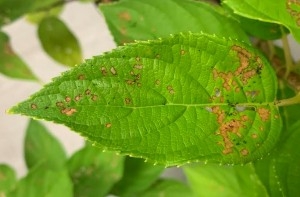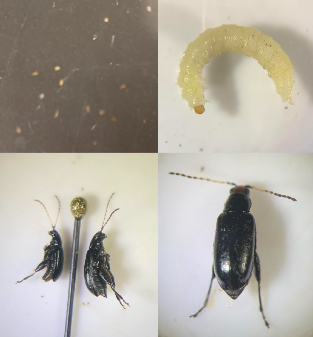Red Headed Flea Beetle in Virginia Nurseries
ID
ENTO-464NP
Introduction
The red headed flea beetle, Systena frontalis Coleoptera: Chrysomelidae, (RHFB) is a prominent pest of ornamentals in open-field nurseries. It has been endemic to the eastern United States since its discovery in the 1800’s, but has only become an economic concern within the past decade throughout the eastern region.
Damage
The RHFB is mainly a defoliating insect, causing damage to the leaves of many ornamental plants. It may also feed on the flowers, however the damage to foliage is much more prominent and severe. The adult beetles will eat small holes into the leaves, often leaving skeletonized brown spots where they did not eat through the entire leaf (Fig. 1). Minute levels of damage can render a plant unsellable, meaning that any amount of RHFB damage present is unacceptable to nurseries. As few as five beetles per plant will cause noticeable damage to the foliage if left untreated. Just one beetle can damage over a quarter of a leaf in as little as 24 hours. The more beetles present, the more damage will occur, and the more it will cost growers to manage it.
Host plants
RHFB can feed on a wide variety of plant material but have shown considerable preference towards a few key plants. Hydrangea paniculta, Itea virginica, and Ilex crenata are some of the most greatly infested and damaged plants in Virginia nurseries. They have also been known to feed on viburnum, dogwood, forsythia, azalea, and at least ten other common ornamentals. They will also feed on weeds such as clover, lambsquarter, and others. They have been a pest on some crops like cranberries and blueberries.


Identification
RHFB adults are around 1/10-1/4 inch long, males being smaller than the females (Fig. 2). RHFB are named for their reddish colored head that contrasts their shiny black body. From a distance however, the difference in coloration may be unclear. They have long antennae as well as robust back legs that allow them to jump like fleas. Their larvae live in the soil of containerized plants and can be difficult to find. They are around 1/4 inch long and white in color with a brown head capsule and a hair-like appendage at the end of their body (Fig. 2). The larvae do not cause measurable damage to infested plants. RHFB eggs are also found in the potting soil. The eggs are no larger than the head of a pin and are tan in color (Fig. 2).
Life cycle
Adults have been observed to emerge in late May and are active throughout the summer and into the fall (late October). The adults lay eggs throughout the summer, giving rise to up to three generations in one year. After the adults die off, their eggs remain in the potted soil over the winter. The eggs hatch and larvae are present in the spring. During the summer months when adults are active, they tend to move around more during the day. They will often be found jumping, flying, walking, mating, and eating. At night, the beetles can mostly be found sitting still on the plant leaves; resting, eating, or mating.
Monitoring
Monitoring is key in managing insect pests. Presence of RHFB can be monitored in a few different ways. Damaged leaves are a clear giveaway that there are insect pests present (Fig. 3). Confirmation of RHFB infestation can be made by finding the beetles themselves. During the day when they are active they can often be found by visual scouting. They will be visible on leaves, but sometimes are tucked away towards the base of the leaf near the stem. They hop like a flea or fly away when disturbed. In more densely packed plants or those with darker colored leaves they may be more difficult to see. They can be caught easily by using a sweep net across sections of plants. This helps show how many beetles may be present in a certain area.

Management
The most common method of managing adults is insecticide sprays. Currently, nurseries may spray up to twice a week when there are high levels of infestation. There are a variety of insecticide options that are effective at killing off adults. To avoid development of resistance, different mode of actions (or IRAC groups) can be alternated. Effective options include pyrethroids, neonicotinoids, and diamides. To read more about specific active ingredients used to control RHFB, please visit our Pest Management Guide series at https://resources.ext.vt.edu/
Virginia Cooperative Extension materials are available for public use, reprint, or citation without further permission, provided the use includes credit to the author and to Virginia Cooperative Extension, Virginia Tech, and Virginia State University.
Virginia Cooperative Extension is a partnership of Virginia Tech, Virginia State University, the U.S. Department of Agriculture (USDA), and local governments, and is an equal opportunity employer. For the full non-discrimination statement, please visit ext.vt.edu/accessibility.
Publication Date
December 21, 2021



